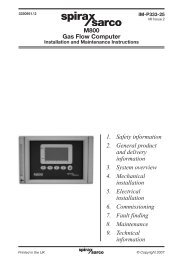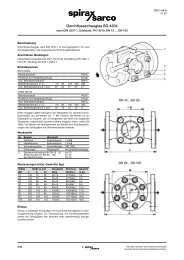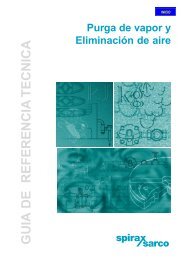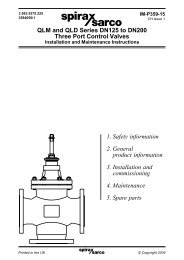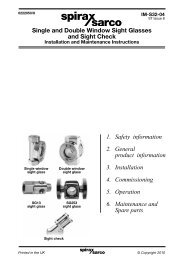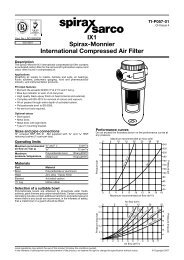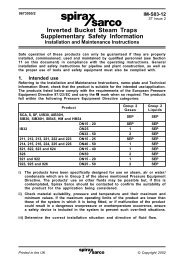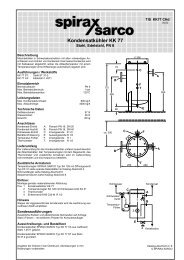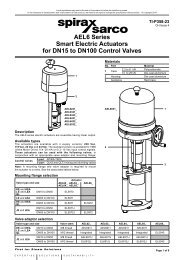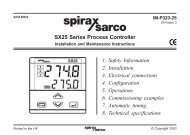Controls & Instrumentation Product Manual - Spirax Sarco
Controls & Instrumentation Product Manual - Spirax Sarco
Controls & Instrumentation Product Manual - Spirax Sarco
Create successful ePaper yourself
Turn your PDF publications into a flip-book with our unique Google optimized e-Paper software.
Control<br />
Valves<br />
Positioners<br />
& Switches<br />
200<br />
SP300<br />
Pneumatic Positioner<br />
Description<br />
The SP300 series is a microprocessor based positioner range that<br />
provides fast and accurate positioning of linear and rotary pneumatic<br />
actuated control valves. The instrument produces a pneumatic pressure<br />
output to accurately position the valve according to the input signal from<br />
external controller (4÷20 mA) or from a bus network (Hart, Foundation<br />
Fieldbus, Profibus PA).<br />
SP300 are compact and easy to maintain and operate. Local calibration<br />
and parameter setting can be done without the need for external<br />
devices.<br />
Position Feedback (Fig. B)<br />
The position of the valve is accurately measured using a magnetic sensor<br />
based on the “Hall effect", eliminating the need for feedback levers and<br />
potentiometers. This non contact feedback arrangement provides many<br />
advantages including improved reliability, safer operation, better accuracy<br />
and dead band because there are less moving parts subject to wear.<br />
Operation<br />
Output Module (Fig. A)<br />
The main parts of the output module are: pilot, servo, Hall effect sensor<br />
and output control circuit.<br />
The instrument CPU sends an electronic setpoint signal to the control<br />
circuit. The control circuit receives an actual valve position feedback signal<br />
from a Hall Effect sensor. By comparing the two signals the control circuit<br />
applies a voltage to the baffle (piezo) for the right valve positioning.<br />
The pneumatic section is based on the well known nozzle-baffle and spool<br />
valve technology.<br />
A piezoelectric disk is used as baffle in the pilot stage. The baffle is deflected<br />
upon receiving the voltage according to the required position change.<br />
A small variation of the air flow through the nozzle causes a change of<br />
pressure in the pilot chamber (pilot pressure).<br />
Because pilot pressure is too low, with no flow capacity, it has to be therefore<br />
boosted. This is done in the servo section which acts as a transducer.<br />
The servo section has one diaphragm in the pilot chamber, and another<br />
smaller diaphragm in the spool chamber. The pilot pressure applies a force<br />
to the pilot side diaphragm which, at steady state, will be equal to the force<br />
that the spool valve applies to the smaller diaphragm.<br />
When a change in position is required, pilot pressure increases or<br />
decreases as explained for the pilot stage. A change in pilot pressure<br />
forces the spool valve up or down changing the output 1 and the output 2<br />
pressure until the desired position is reached.<br />
Flow<br />
Piezo<br />
restriction<br />
Baffle<br />
Fig A<br />
Magnetic Sensor<br />
Pilot<br />
Diaphragm<br />
Spool<br />
Disphragm<br />
Air<br />
Supply<br />
Spool<br />
Valve<br />
Nozzle<br />
Pilot Chambe<br />
Vent 2<br />
Output 2<br />
Output 1<br />
Vent 1<br />
Spring<br />
Fig B Magnetic Sensor<br />
Linear Magnet<br />
Rotary Magnet<br />
Local regulation may restrict the use of this product below the conditions quoted. Limiting conditions refer to standard connections only.<br />
In the interests of development and improvement of the product, we reserve the right to change the specification.<br />
Remote<br />
Sensor<br />
(optional)<br />
Linear<br />
Magnet<br />
or<br />
Rotary<br />
Magnet<br />
The mounting arrangement for linear actuators complies with IEC534-6<br />
The mounting arrangement for rotary actuators complies with VDI/<br />
VDE3845<br />
The “Hall effect" sensor can be remotely mounted upto 65 ft from the<br />
instrument. This is particularly useful for applications subject to high<br />
ambient temperatures or heavy vibration.<br />
TI-P370-19-US 6.07



